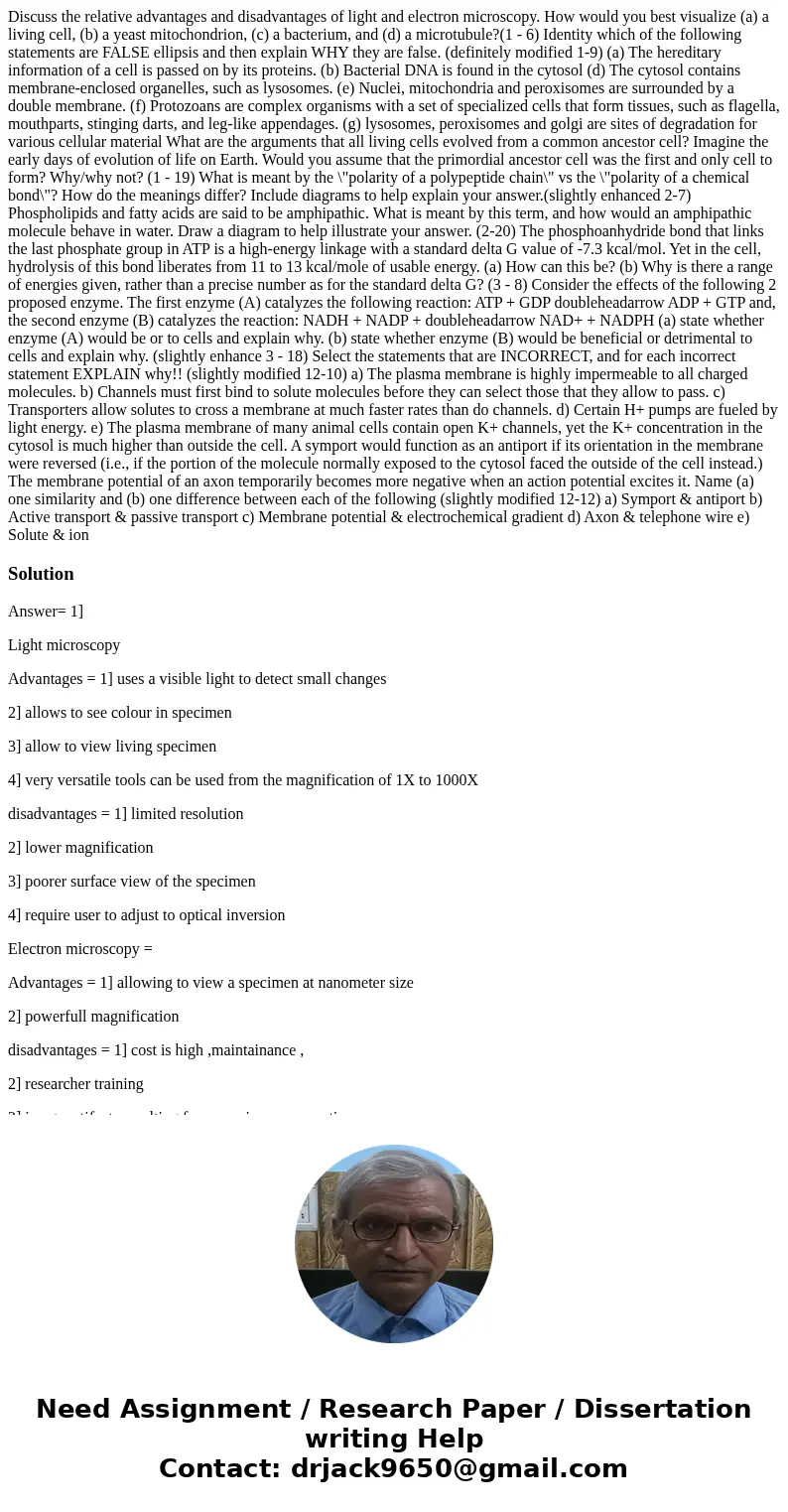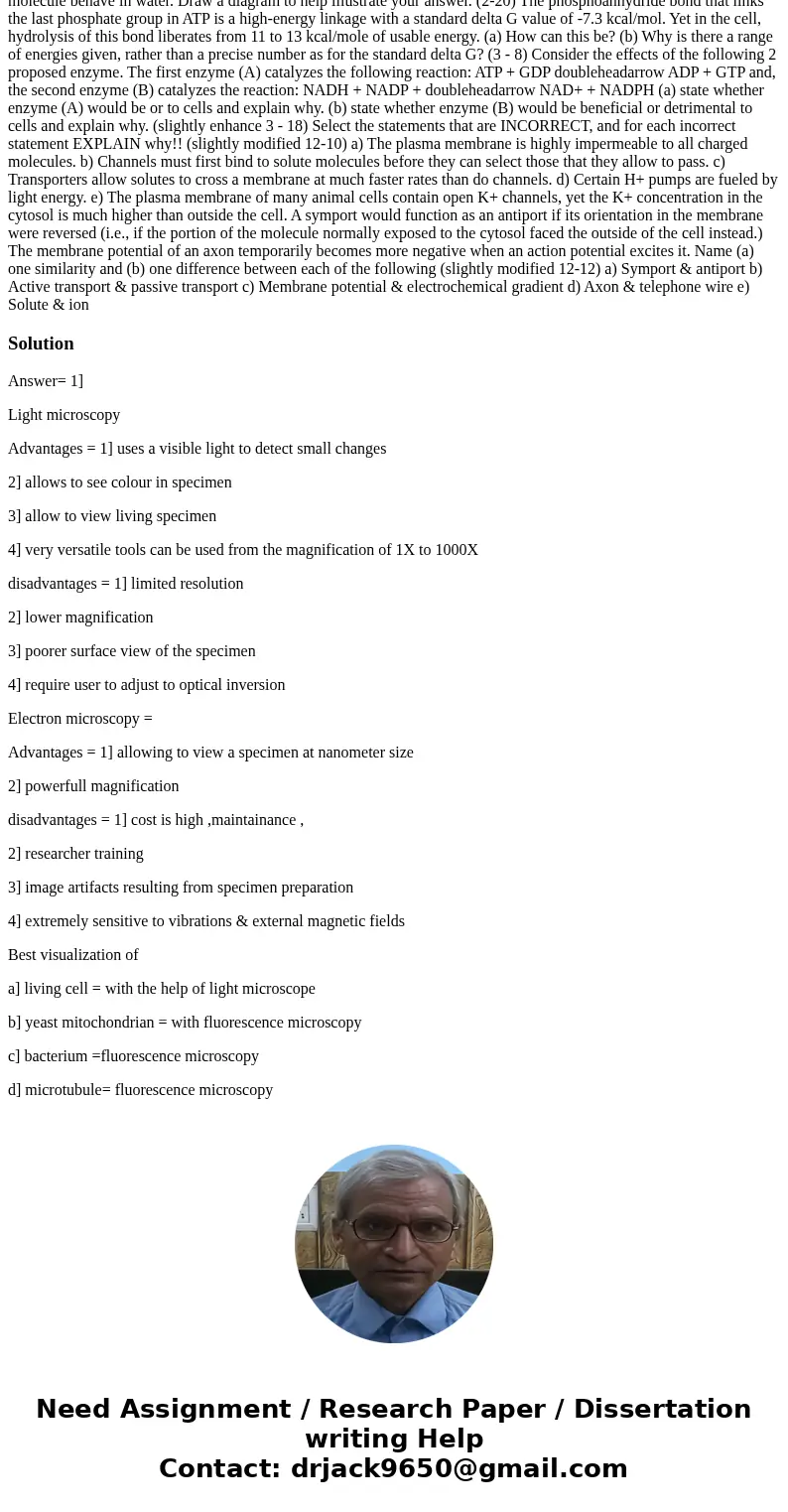Discuss the relative advantages and disadvantages of light and electron microscopy. How would you best visualize (a) a living cell, (b) a yeast mitochondrion, (c) a bacterium, and (d) a microtubule?(1 - 6) Identity which of the following statements are FALSE ellipsis and then explain WHY they are false. (definitely modified 1-9) (a) The hereditary information of a cell is passed on by its proteins. (b) Bacterial DNA is found in the cytosol (d) The cytosol contains membrane-enclosed organelles, such as lysosomes. (e) Nuclei, mitochondria and peroxisomes are surrounded by a double membrane. (f) Protozoans are complex organisms with a set of specialized cells that form tissues, such as flagella, mouthparts, stinging darts, and leg-like appendages. (g) lysosomes, peroxisomes and golgi are sites of degradation for various cellular material What are the arguments that all living cells evolved from a common ancestor cell? Imagine the early days of evolution of life on Earth. Would you assume that the primordial ancestor cell was the first and only cell to form? Why/why not? (1 - 19) What is meant by the \"polarity of a polypeptide chain\" vs the \"polarity of a chemical bond\"? How do the meanings differ? Include diagrams to help explain your answer.(slightly enhanced 2-7) Phospholipids and fatty acids are said to be amphipathic. What is meant by this term, and how would an amphipathic molecule behave in water. Draw a diagram to help illustrate your answer. (2-20) The phosphoanhydride bond that links the last phosphate group in ATP is a high-energy linkage with a standard delta G value of -7.3 kcal/mol. Yet in the cell, hydrolysis of this bond liberates from 11 to 13 kcal/mole of usable energy. (a) How can this be? (b) Why is there a range of energies given, rather than a precise number as for the standard delta G? (3 - 8) Consider the effects of the following 2 proposed enzyme. The first enzyme (A) catalyzes the following reaction: ATP + GDP doubleheadarrow ADP + GTP and, the second enzyme (B) catalyzes the reaction: NADH + NADP + doubleheadarrow NAD+ + NADPH (a) state whether enzyme (A) would be or to cells and explain why. (b) state whether enzyme (B) would be beneficial or detrimental to cells and explain why. (slightly enhance 3 - 18) Select the statements that are INCORRECT, and for each incorrect statement EXPLAIN why!! (slightly modified 12-10) a) The plasma membrane is highly impermeable to all charged molecules. b) Channels must first bind to solute molecules before they can select those that they allow to pass. c) Transporters allow solutes to cross a membrane at much faster rates than do channels. d) Certain H+ pumps are fueled by light energy. e) The plasma membrane of many animal cells contain open K+ channels, yet the K+ concentration in the cytosol is much higher than outside the cell. A symport would function as an antiport if its orientation in the membrane were reversed (i.e., if the portion of the molecule normally exposed to the cytosol faced the outside of the cell instead.) The membrane potential of an axon temporarily becomes more negative when an action potential excites it. Name (a) one similarity and (b) one difference between each of the following (slightly modified 12-12) a) Symport & antiport b) Active transport & passive transport c) Membrane potential & electrochemical gradient d) Axon & telephone wire e) Solute & ion
Answer= 1]
Light microscopy
Advantages = 1] uses a visible light to detect small changes
2] allows to see colour in specimen
3] allow to view living specimen
4] very versatile tools can be used from the magnification of 1X to 1000X
disadvantages = 1] limited resolution
2] lower magnification
3] poorer surface view of the specimen
4] require user to adjust to optical inversion
Electron microscopy =
Advantages = 1] allowing to view a specimen at nanometer size
2] powerfull magnification
disadvantages = 1] cost is high ,maintainance ,
2] researcher training
3] image artifacts resulting from specimen preparation
4] extremely sensitive to vibrations & external magnetic fields
Best visualization of
a] living cell = with the help of light microscope
b] yeast mitochondrian = with fluorescence microscopy
c] bacterium =fluorescence microscopy
d] microtubule= fluorescence microscopy


 Homework Sourse
Homework Sourse